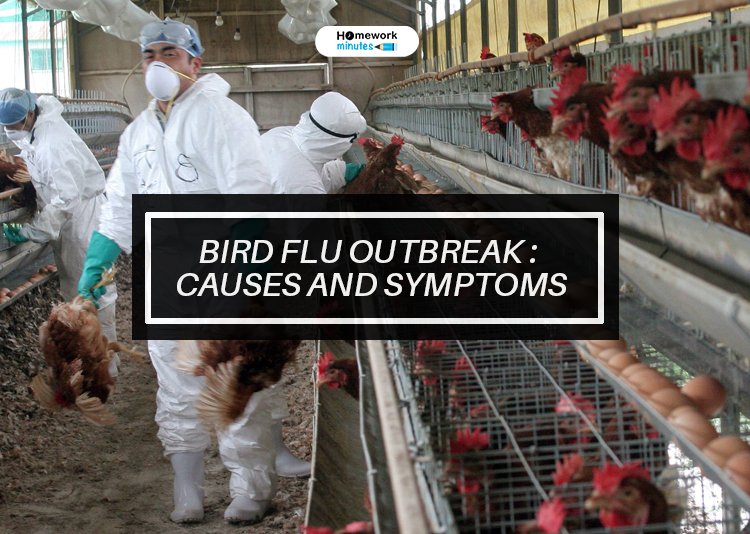Bird flu outbreak, in other words, is avian influenza. It is a viral infection that harms birds as well as humans and other animals also. Various forms of the virus are inadequate for birds.
The most common bird flu is H5N1. It is very dangerous for birds and for them who come in contact with this flu-like human and other animals.
According to the World Health Organization (WHO), in 1997, H5N1 first came across in humans, and nearly a 60percent were killed by this flu.
Presently, experts don’t find any clue of spreading the virus from human to human. But some experts worry that H5N1 may become a risk of a pandemic that threatens humans.
Also read:
https://www.homeworkminutes.com/blog/learning/child-development-stages-meaning-and-its-importance/
Symptoms of Bird Flu
If you are suffering from H5N1, you may experience typical flu-like symptoms:
- Muscle ache
- Running nose
- Cough
- Sore throat
- Fever
- Diarrhoea
- Breathing problems
Please keep in mind if you are suffering from these symptoms, you have to inform doctors or staff members before coming to the hospital. They can arrange necessary things for your cure or take safety measures because it’s a viral fever, and this flu can also spread from human to human. So safety precautions are necessary for control spreading.
Bird Flu Causes
Even though there are many types of bird flu, the first virus that infects humans is the H5N1 avian influenza virus. In 1997, the first infection developed in Hong Kong. Bird flu outbreak was associate with grasping infected poultry.
H5N1 quickly spreads into domestic poultry, but it naturally happens in wild waterfowl. This flu can be transfer to humans when humans come in contact with nasal secretion, infected bird faeces, and secretion from the eyes and mouth.
If humans consumed fully cooked eggs or poultry from infected birds. It doesn’t transfer the avian influenza bird flu, but you have to be careful about serving runny eggs because it’s not good. Also, if meat is properly cooked to an internal temperature of 165 degrees Fahrenheit, it considers safe to eat.
Risk Factor of Bird Flu
H5N1 avian influenza has the potential to continue for an extended period of time. At least for ten days, birds who are infected with H5N1 release infected virus faeces and saliva. That’s why it increases the risk factor of spreading viruses.
You may have at significant risk of H5N1 if you are:
- A poultry farmer
- Exposed to infected birds
- Who eats undercooked eggs and chicken
- A health care workers who take care of an infected person
- A traveller visiting affected areas
- Family members of the infected person
Treatment of Bird Flu
Most treatment occurs with antiviral medication such as zanamivir or oseltamivir to reduce the intensity of bird flu diseases. Although at least within 48 hours of symptoms appearing, should take medication.
The human form of bird flu outbreak can develop antibiotic resistance to the two forms of antiviral medication, rimantadine and amantadine. This medication couldn’t be used to treat diseases.
For your family or others who have close contact with you, for their benefit, you prescribed them antivirals as a preventive measure, even if they are sick or not sick. Doctors may put you in isolation for your beneficiary or for others also because it avoids spreading the virus.
If you develop a severe infection, the doctor may place you on a mechanical ventilator in critical condition.
Prevention of Bird Flu
To prevent bird flu, doctors recommend the flu vaccine so you can’t get the human strain of influenza H5N1. Please be aware that if you have influenza flu fever or normal fever simultaneously, it may create a deadly and new form of flu.
Centres for Disease Control and Prevention(CDC) has not issued any guidelines against travelling to countries for those who affected by H5N1. You can minimize the risk by avoiding the following;
- Open-air market
- Contact with infected birds
- Undercooked poultry
For your safety, please make sure you wash your hands regularly and maintain hygiene. The FDA approved a vaccine against avian influenza H5N1, but the vaccine is not currently available for public use. Although, experts of FDA said the H5N1 avian influenza vaccine will be use when people come in contact with this virus.
Avian influenza bird flu viruses are divided into two forms depending on their pathogenicity; it is high pathogenicity or low pathogenicity found in North America. Mostly, pigeons come in contact with avian flu, but they aren’t able to transmit it.
Avian influenza virus is hazardous, and its symptoms are shown in two to eight days. Still, if you take proper precautions for your safety and maintain hygiene, it can’t harm you and increases the mortality rate if it occurs in humans. This virus happened naturally, so we can’t know when and where it comes; that’s why our safety is our priority.


